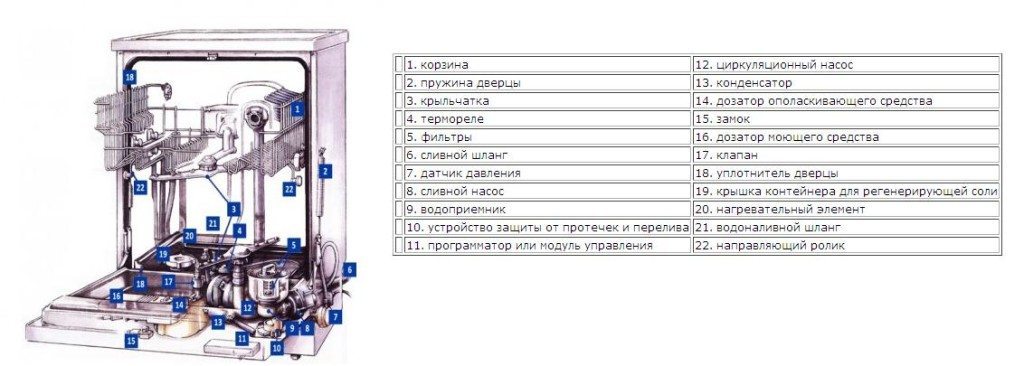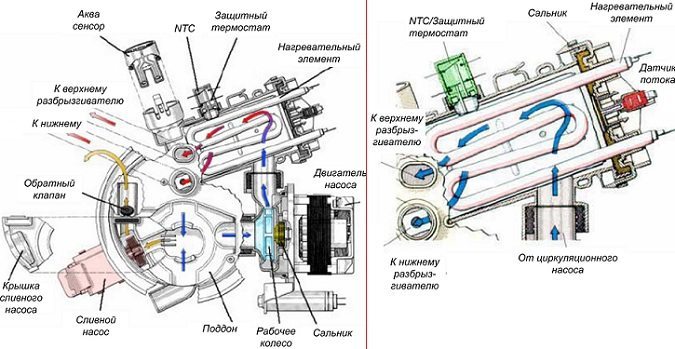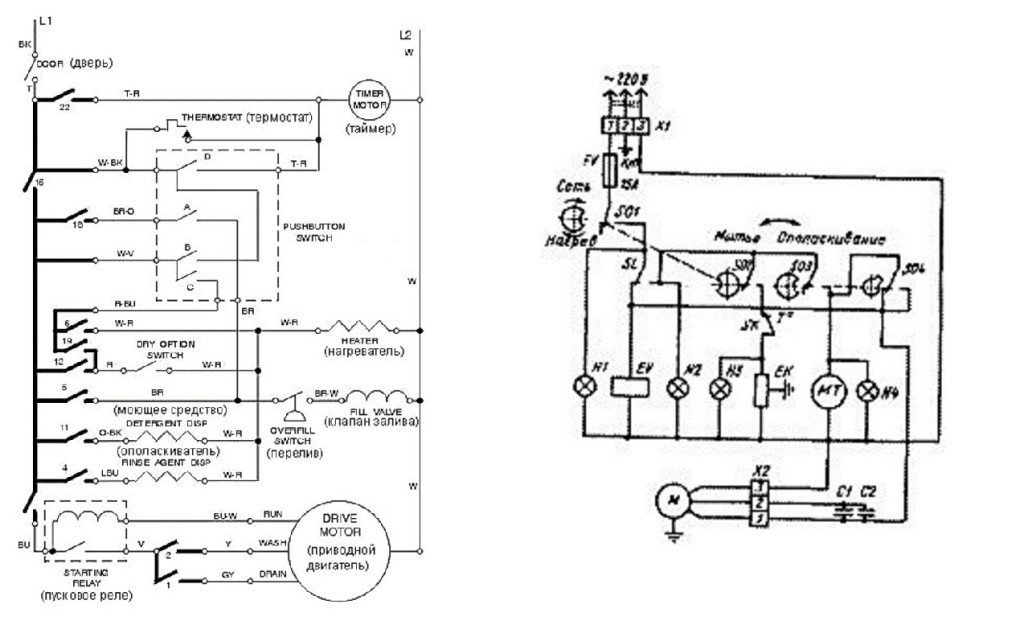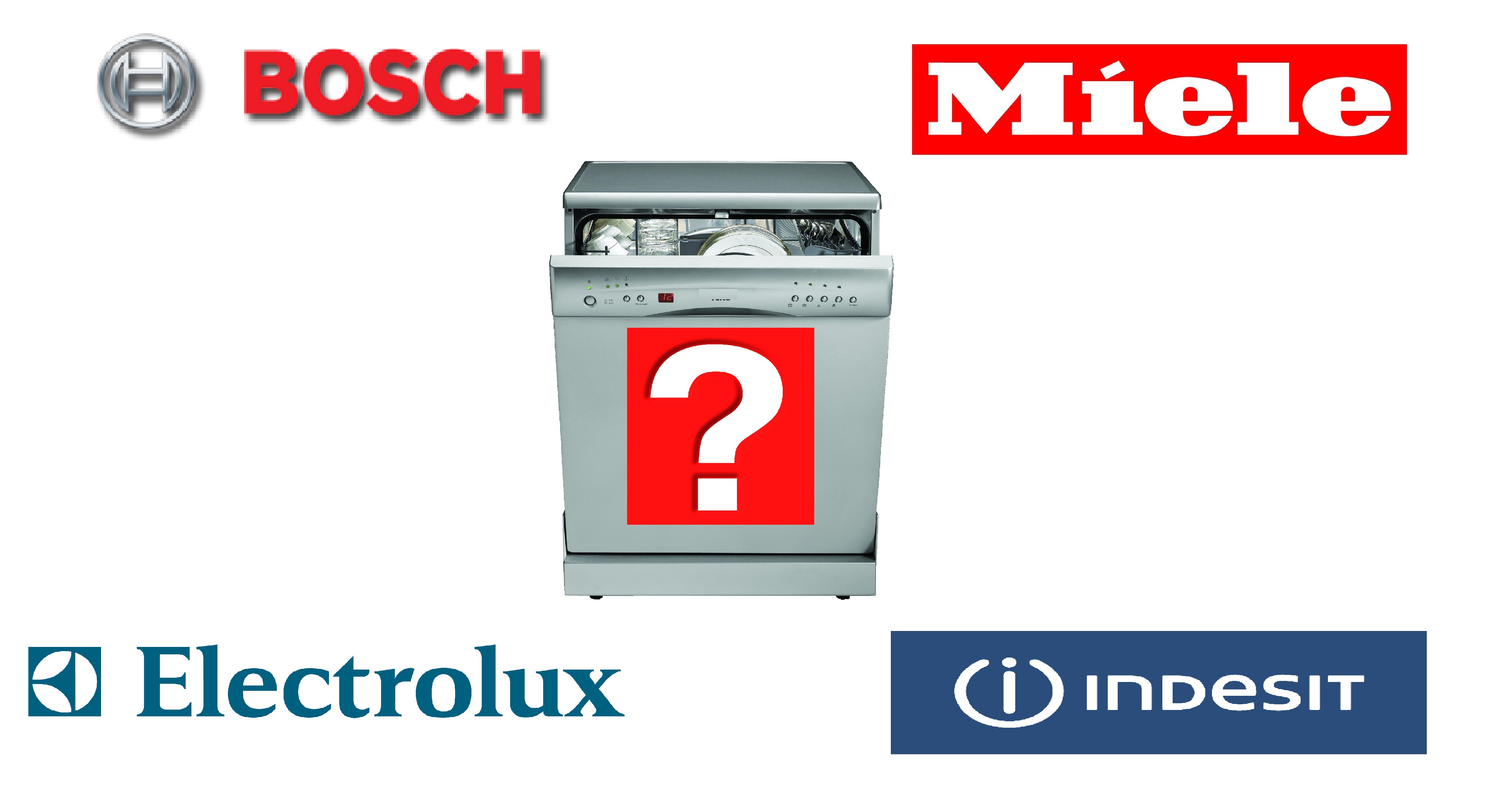Dishwasher diagrams
 To begin repairing a dishwasher yourself, you need to have an idea of its internal structure and the purpose of each unit. An electrical circuit may also be required, although if problems arise with the electronic module, then the chances of properly repairing the “dishwasher” are very slim. We will talk about how a dishwasher works, the location and functions of its internal elements in this article.
To begin repairing a dishwasher yourself, you need to have an idea of its internal structure and the purpose of each unit. An electrical circuit may also be required, although if problems arise with the electronic module, then the chances of properly repairing the “dishwasher” are very slim. We will talk about how a dishwasher works, the location and functions of its internal elements in this article.
What do all dishwashers have in common?
Modern dishwashers of any brand, be it Bosch Electrolux or Indesit, have quite a lot in common, despite the fact that their appearance may differ. The main similarity is in the functions and arrangement of internal elements. By going to a retail outlet that specializes in selling household appliances, you can conduct an experiment. Go to the row of dishwashers and open the doors of several of them. Inside each you will see approximately the same sprinklers, approximately the same baskets and trays.
If you come across a schematic diagram of a dishwasher, you will understand that there are many more similarities between different models of machines than differences. Although they differ in design, size, software packages and the presence of various specific functions, the concept is still applicable to all models.
For your information! Some people believe that compact dishwashers differ significantly in their internal structure from narrow and standard ones. In fact, this is not the case, the only difference is in the size of the dish tank.
- Absolutely all models of dishwashers (no matter Bosch, Electrolux or others) have a tank (or hopper) in which baskets for dishes are located. These dishes are placed in them.
- Each model has a spray head or spray arms that shoot streams of water onto dirty dishes, cleaning them.
- All dishwashers have a circulation pump that circulates the collected water, feeding it in a circle through the spray arms into the tank.
- All also have a drain pump and heater. The first drains waste water into the sewer, and the second heats the water to the required temperature so that the dishes are washed with warm or hot water (depending on the program).
- Every dishwasher has a cuvette for detergents; of course, the cuvettes are designed differently and their functionality is also different, but their operating principle is approximately the same.
This list can be continued for a long time, but I think the meaning is already clear - all dishwashers are very similar to each other. All that remains is to disassemble their device in more detail and everything will fall into place.
How does a dishwasher work?

The structure of a dishwasher can be clearly represented in the diagram. As you can see, there are not so many elements that fit in it, there are not much more than 20 of them in total. You can look at the names of the elements in the figure, but it is impossible to immediately understand how they work and how they interact with each other.
- The basket is designed to accommodate dishes; it is placed on special guides and slides directly into the dishwasher tank
Note! The tank is usually called the working space inside the dishwasher where dishes are washed.
- Door springs or door closers are designed to close the door smoothly. Thanks to the closers, the door does not slam, the closing and locking mechanism does not wear out and can last much longer.
- Thanks to rotating impellers located at the bottom and top of the tank, powerful streams of hot water hit the dishes from all sides, ensuring high-quality washing.

- The temperature relay, indicated in the figure as number 4, allows you to regulate the temperature of the water supplied to the tank.
- Garbage filters are needed so that food residues and other debris washed off from dishes settle on them.
- The drain hose, indicated in the figure as number 6, helps drain the water used by the machine into the sewer.
- The pressure switch determines the amount of water pumped into the tank, so the machine knows exactly when to start and stop pouring water, and when to discharge waste water.
- The pump is used to pump waste water into the sewer system.
- A reservoir or water inlet is needed to accumulate clean water, which will be used for washing dishes.
- The leak protection system, designated number 10, allows you to shut off the water in the event of a leak and thereby save your property and the property of your neighbors.
- At number 11 there is a control unit that provides interaction with all dishwasher sensors and allows you to set the desired washing program.
- The heart of the dishwasher is the circulation pump (number 12). It is he who directly washes the dishes, supplying hot water from the tank through the impeller into the “dishwasher” tank directly onto the dirty dishes.
- The surge protector protects the dishwasher from power surges.
- At number 16 there is a detergent cuvette into which 3 in 1 tablets, powder, liquid detergent and rinse aid are loaded, each in its own compartment.
- At number 17 there is a filler valve that shuts off the water supply and allows you to collect the same water if necessary.
- Number 18 indicates a rubber seal that serves to seal the door.
- The number 19 indicates a container with a lid in which special regenerating salt is poured.
- The number 20 denotes the dishwasher heating element, which heats the water for washing dishes. When the heating element breaks, it is required replacing heating element in dishwasher. You can do the replacement yourself.
- Number 21 indicates the inlet hose. Through it, tap water flows directly into the dishwasher. For safety reasons, modern equipment manufacturers protect inlet hoses with a leakage protection system.
- And finally, number 22 marks the guide that allows you to place the dish basket level inside the tank.
For your information! All dishwashing equipment has the above elements; each element must function normally, otherwise the machine will simply stop working.
Electrical diagram of a dishwasher
We looked at the basic layout of components and assemblies in a dishwasher from Bosch, Siemens, Aeg and others. But this is not enough for high-quality repairs, because a problem can arise not only with one of the components and assemblies, but also with an element of the electronic and electrical circuit. To identify a breakdown in an electrical circuit, you will need to study the diagram of this electrical circuit.In the figure below we have placed just such a chain, study it carefully and you can begin repairing the “iron” assistant.

To summarize, we note that when looking at the circuit diagrams of various dishwashers, you come to the conclusion that they are all almost the same (or at least most of them). This means you need to study the circuit diagram in order to repair such equipment in the future without any problems.
Interesting:
Reader comments
- Share your opinion - leave a comment
Categories
Washing machine repair


For buyers

For users

Dishwasher

















Add a comment